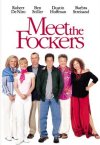BUY THE DVD:
|


|
|
|
SYNOPSIS:
| |
all hell breaks loose when the byrnes family meets the focker family for the first time.
|
|
|
MOVIE FACT:
| |
teri polo accidentally called barbara streisand "boob," which ended up becoming her on-set nickname.
|
|
|
RATING:
|


two out of four possible stars
|
|
|
|
After the runaway success of Meet the Parents, it was only a matter of time before Ben Stiller again took up the personality of "Gaylord Focker," the well-meaning yet completely inept future son-in-law to militant patriarch ďJack Byrnes,Ē played by Robert De Niro. In Meet the Fockers, viewers will be hard pressed to decide whether ďPam Byrnes,Ē played by Teri Polo, is worse off due to her fatherís insanity or her fiancťís stupidity. Or the screenwritersí lethargy.
But the small detail of the protagonistís plight, the put-upon and soon to be married Gaylord and Pam, takes a seat in the caboose of this odd comedy, as Barbara Streisand and Dustin Hoffman, portraying the Focker parents of title fame, trounce all over the rest of the cast with their comedic hilarity. Eclipsing even the lauded De Niro with their beautiful chemistry as man and wife, all enjoyment in this film is derived directly from Streisand and Hoffmanís sincere performances. And as much as it might pain some fans to hear it, De Niro is far from his best in his performance as an overbearing, prudish and practically psychotic future father-in-law to Stiller. De Niroís clichť and worn-out character is also made less appealing by the fact that the actors on the other side of the family are so much funnier.
Stacked to the brim with various sex related jokes and comedy highlighting various defecations, some of these baser jokes are inserted easily into the story and seem a natural extension of the plot given Mrs. Fockerís chosen profession as a sex therapist. Streisandís first scene, involving a class of geriatric couples learning about senior-friendly sexual positions, is an entertaining and lively debut for her character and although itís a surprise to see the shy singer display her comedic abilities in such a fashion, her performance is a welcome return to the screen after a nearly ten year absence (perhaps this role will convince her that she should grace us with her presence more than once a decade?).
But contrast Streisandís vivacious and welcome performance with the scene where the Fockerís dog is flushed down a toilet by the Byrnesís dog. Funny? Perhaps if youíre slightly inebriated. But itís hardly more than a set-piece that has nothing to do with the filmís characters and story. But despite this not unexpected habit of inserting non-sequitur plot devices into the film, the screenwriters seem to have done a decent in creating bodily function pratfalls that actually have some influence from the characters. Many slap-stick comedies donít bother to do this, though Fockersí success is partly owed to Mrs. Fockerís convenient profession.
It is a mark against Ben Stiller however that while his screen parents create such a fantastic duo, that his performance is the most dull of the film. Stiller is one of the most famous examples of an actor who plays the same character in every film he bothers to audition for. But unlike some performers who can get away with such a charade and still retain audience favor (Christopher Walken and Jack Nicholson come immediately to mind), Stiller was never entertaining to begin with. Attempting to insert something a little deadpan with some tried-and-true physical comedy, Stillerís journey into laughter is about as interesting as watching paint dry. And a boring color of paint it is, too. Like beige. Or light beige.
One of Stillerís breakout roles, in 1994ís Reality Bites, was a ďstraightĒ role where he was actually rather successful in creating a sincere character. Since his flight into comedy, his characters have been, every one of them, the same exact type of person. Like the mindless performance of an actor whoís been on stage for a decade in the same role, Stiller hasnít bothered to refine his talent under his comedic guise. One wonders why Stiller hasnít ventured back into the world of drama. (hint, Mr. Stiller).
To Stillerís great fortune, viewers of Meet the Fockers need not be so concerned about his forgettable attempt at drawing laughs from the audience. There is the dynamic duo of Streisand and Hoffman who fill with ease the hole left by Stillerís inadequate performance. Although Hoffman has seen his star shine in a variety of different films in every genre over the past decade, it is fortunate for Streisand that she chose to return to the screen in this film at Dustinís side. If there is anyone who might have forgotten about or doubted her comedic abilities, her role in this film should revive that forgotten memory.
In most respects, Meet the Fockers is a superior film it is predecessor, mostly because of the additional casting. As Parents tread comedic floorboards that have been worn out previously by much funnier farces, Fockers takes that same idea and doesnít quite give it a complete facelift, but makes it more believable and sincere nevertheless, which might allow it attract a more varied demographic. Whenever Hoffman and Streisand share the screen, this film is bubbly and vivacious. Whenever they are absent, itís an entirely less appealing affair.
Review by Kelsey Wyatt.
| |
|